Related Research Articles

Field Marshal Bernard Law Montgomery, 1st Viscount Montgomery of Alamein,, nicknamed "Monty" and "The Spartan General", was a senior British Army officer who fought in both the First World War and the Second World War.

Free France and its Free French Forces were the government-in-exile led by Charles de Gaulle during the Second World War and its military forces, that continued to fight against the Axis powers as one of the Allies after the fall of France. Set up in London in June 1940, it organised and supported the Resistance in occupied France.
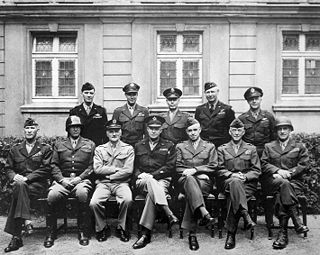
The European Theater of Operations, United States Army (ETOUSA) was a Theater of Operations responsible for directing United States Army operations throughout the European theatre of World War II, from 1942 to 1945. It commanded Army Ground Forces (AGF), United States Army Air Forces (USAAF), and Army Service Forces (ASF) operations north of Italy and the Mediterranean coast. It was bordered to the south by the North African Theater of Operations, United States Army (NATOUSA), which later became the Mediterranean Theater of Operations, United States Army (MTOUSA).

The military history of the United Kingdom in World War II covers the Second World War against the Axis powers, starting on 3 September 1939 when Britain and France, followed by most of Britain's Dominions and Crown colonies, declared war on Nazi Germany in response to the invasion of Poland by Germany. Winston Churchill became prime minister and head of a coalition government in May 1940. Despite the defeat of its European allies and the British Expeditionary Force in the first year of the war leading to the Dunkirk evacuation, Britain and its Empire continued the fight alone against Germany. Churchill engaged industry, scientists and engineers to advise and support the government and the military in the prosecution of the war effort. Germany's planned invasion of the UK was averted by its failure to establish air superiority in the Battle of Britain, and by its marked inferiority in naval power. Subsequently, urban areas in Britain suffered heavy bombing during the Blitz in late 1940 and early 1941.
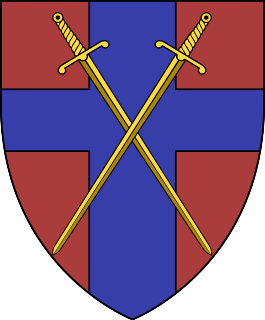
There have been two formations named British Army of the Rhine (BAOR). Both were originally occupation forces in Germany, one after the First World War, and the other after the Second World War. Both formations had areas of responsibility located around the German section of the River Rhine.

The 21st Army Group was a World War II British headquarters formation, in command of two field armies and other supporting units, consisting primarily of the British Second Army and the First Canadian Army. Established in London during July 1943, under the command of Supreme Headquarters Allied Expeditionary Force (SHAEF), it was assigned to Operation Overlord, the Western Allied invasion of Europe, and was an important Allied force in the European Theatre. At various times during its existence, the 21st Army Group had additional British, Canadian, American and Polish field armies or corps attached to it. The 21st Army Group operated in Northern France, Luxembourg, Belgium, the Netherlands and Germany from June 1944 until August 1945, when it was renamed the British Army of the Rhine (BAOR).

The VI Corps was activated as VI Army Corps in August 1918 at Neufchâteau, France, serving in the Lorraine Campaign. Constituted in the Organized Reserves in 1921, it was allotted to the Regular Army in 1933 and activated on 1 August 1940 at Fort Sheridan, Illinois. VI Corps took part in some of the most high-profile operations in World War II.

The Western Front was a military theatre of World War II encompassing Denmark, Norway, Luxembourg, Belgium, the Netherlands, the United Kingdom, France, Italy, and Germany. World War II military engagements in Southern Europe and elsewhere are generally considered as separate theatres. The Western Front was marked by two phases of large-scale combat operations. The first phase saw the capitulation of the Netherlands, Belgium, and France during May and June 1940 after their defeat in the Low Countries and the northern half of France, and continued into an air war between Germany and Britain that climaxed with the Battle of Britain. The second phase consisted of large-scale ground combat, which began in June 1944 with the Allied landings in Normandy and continued until the defeat of Germany in May 1945.
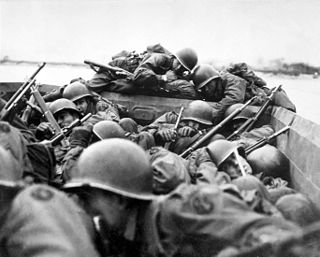
Operation Plunder was a military operation to cross the Rhine on the night of 23 March 1945, launched by the 21st Army Group under Field Marshal Bernard Montgomery. The crossing of the river was at Rees, Wesel, and south of the river Lippe by the British Second Army under Lieutenant General Sir Miles Dempsey, and the United States Ninth Army under Lieutenant General William H. Simpson.
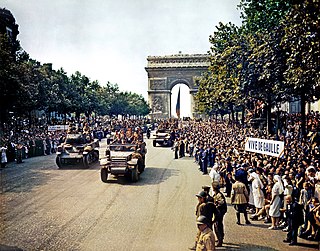
The Liberation of Paris was a military battle that took place during World War II from 19 August 1944 until the German garrison surrendered the French capital on 25 August 1944. Paris had been ruled by Nazi Germany since the signing of the Second Compiègne Armistice on 22 June 1940, after which the Wehrmacht occupied northern and western France.

Operation Varsity was a successful airborne forces operation launched by Allied troops that took place toward the end of World War II. Involving more than 16,000 paratroopers and several thousand aircraft, it was the largest airborne operation in history to be conducted on a single day and in one location.

The Allied advance from Paris to the Rhine, also known as the Siegfried Line campaign, was a phase in the Western European campaign of World War II.

The Allies of World War II, called the United Nations from the 1 January 1942 declaration, were the countries that together opposed the Axis powers during the Second World War (1939–1945). The Allies promoted the alliance as a means to control German, Japanese and Italian aggression.
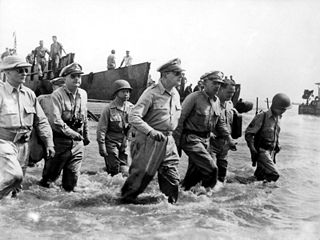
The Philippines campaign, Operation Musketeer, Battle of the Philippines or the Liberation of the Philippines, , was the American and Filipino campaign to defeat and expel the Imperial Japanese forces occupying the Philippines during World War II. The Japanese Army overran all of the Philippines during the first half of 1942. The liberation of the Philippines commenced with amphibious landings on the eastern Philippine island of Leyte on October 20, 1944. United States and Philippine Commonwealth military forces were progressing in liberating territory and islands when the Japanese forces in the Philippines were ordered to surrender by Tokyo on August 15, 1945, after the dropping of the atomic bombs on mainland Japan and the Soviet invasion of Manchuria.

Australia entered World War II on 3 September 1939, following the government's acceptance of the United Kingdom's declaration of war on Nazi Germany. Australia later entered into a state of war with other members of the Axis powers, including the Kingdom of Italy on 11 June 1940, and the Empire of Japan on 9 December 1941. By the end of the war, almost a million Australians had served in the armed forces, whose military units fought primarily in the European theatre, North African campaign, and the South West Pacific theatre. In addition, Australia came under direct attack for the first time in its post-colonial history. Its casualties from enemy action during the war were 27,073 killed and 23,477 wounded.

The Balochistan Liberation Army, also known as the Baloch Liberation Army, is a militant organization based in Afghanistan. The BLA is listed as a terrorist organization by Pakistan, United Kingdom and the United States. Since 2004 the BLA has waged a violent armed struggle against Pakistan for what it claims as self-determination for the Baloch people and separation of Balochistan from Pakistan and has been involved in ethnic-cleansing of non-Baloch minorities in Balochistan. The BLA is operating mainly in Balochistan, the largest province of Pakistan where it carries out attacks against the Pakistan Armed Forces, civilians and foreign nationals. The Baloch Liberation Army became publicly known during the summer of 2000, after it claimed credit for a series of bombing attacks on Pakistani authorities.

The Western Allied invasion of Germany was coordinated by the Western Allies during the final months of hostilities in the European theatre of World War II. In preparation for the Allied invasion of Germany, a series of offensive operations were designed to seize and capture the east and west bank of the Rhine River: Operation Veritable and Operation Grenade in February 1945, and Operation Lumberjack and Operation Undertone in March 1945. The Allied invasion of Germany started with the Western Allies crossing the Rhine on 22 March 1945 before fanning out and overrunning all of western Germany from the Baltic in the north to the Alpine passes in the south, where they linked up with troops of the U.S. Fifth Army in Italy. Combined with the capture of Berchtesgaden, any hope of Nazi leadership continuing to wage war from a so-called "National redoubt" or escape through the Alps was crushed, shortly followed by unconditional German surrender on 8 May 1945. This is known as the "Central Europe campaign" in United States military histories.

The Allied leaders of World War II listed below comprise the important political and military figures who fought for or supported the Allies during World War II. Engaged in total war, they had to adapt to new types of modern warfare, on the military, psychological and economic fronts.

II Canadian Corps was a corps-level formation that, along with I (British) Corps and I Canadian Corps, comprised the First Canadian Army in Northwest Europe during World War II.
France was the largest military power to come under occupation as part of the Western Front in World War II. The Western Front was a military theatre of World War II encompassing Denmark, Norway, Luxembourg, Belgium, the Netherlands, the United Kingdom, France, Italy, and Germany. The Western Front was marked by two phases of large-scale combat operations.
References
- ↑ Buckley, John (2013). Monty's Men: The British Army and the Liberation of Europe. New Haven: Yale University Press. p. 20. ISBN 9780300134490.
- ↑ "Monty's "Army Of the Rhine"". The Telegraph . Queensland, Australia. 25 August 1945. p. 1. Retrieved 26 October 2016– via National Library of Australia.
| This United Kingdom military article is a stub. You can help Wikipedia by expanding it. |